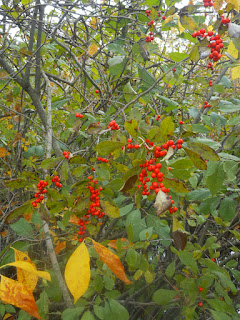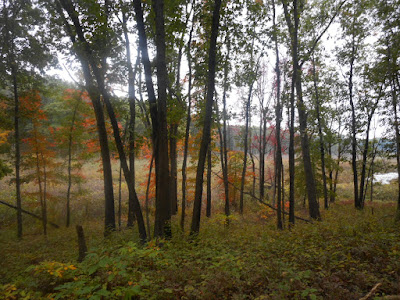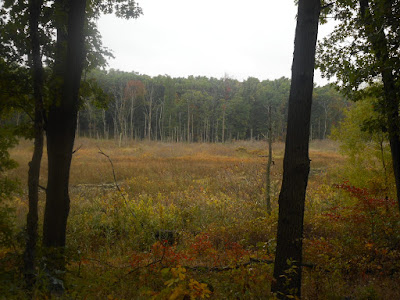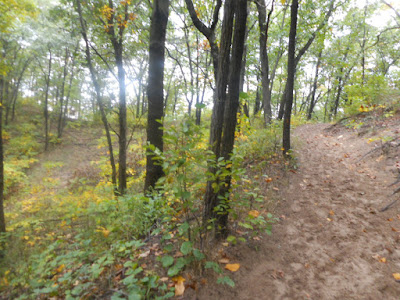Cowles Bog Trail: Walking Part of the Great Marsh of the Indiana Dunes
October 16, 2016
One of my favorite places to be is the Indiana Dunes off the southern tip of Lake Michigan. One of my favorite places to be in the Indiana Dunes is the Cowles Bog Trail. Richard and I had walked the trail several years before and it has been trying to draw me back ever since. But, few visits to the Dunes during the intervening years meant that we were trying to use our time to explore trails we had not walked before. This year, 2016, had been a complex one, so we had not been able to visit the Dunes until mid October - and then we chose to return to Cowles Bog Trail.
Why had I always felt drawn back to Cowles Bog? Maybe it was the other-worldly feel of the place. The first time we went was at the end of the very green month of May. Everything seemed giant to me - the huge, spreading fronds of ferns with towering spikes, the stacks of tremendous Skunk Cabbage leaves, arrayed in gargantuan rosettes, and the very tall irises and cat-tails. My eyes grew larger, trying to take in all the enormity.
Tree bark ranged from thin and papery to huge, thick, blocky designs. The wispy yet angular design of Tamaracks contrasted with deciduous trees and pines. Below it all was the murky mire of mud and water, seeming to hold dark secrets, and sometimes partially covering rotten, soaked logs, themselves covered thickly in mosses and young plants. I felt I had stepped into an ancient time, and I half expected giant dragonflies to dart through the tall vegetation.
Though I had grown up not far from this place, in the land of sand ridges, savannas, soggy fields and swamps, I had never seen a place like Cowles Bog.
Cowles Bog is not truly a "bog", as it is more alkaline than a bog (to see a true quaking bog in the Dunes area, visit Pinhook Bog, south of LaPorte, during one of the ranger-led tours there.) More properly, Cowles Bog is a "fen" which, according to Merriam-Webster Dictionary, is a "low land that is covered wholly or partly with water ... and that usually has peaty alkaline soil and characteristic flora (as of sedges and reeds)." Cowles is part of the Great Marsh complex at the Indiana Dunes, which was formed when water was trapped between successive dune formations (see my blog post published on July 2, 2013 called "The Great Marsh of the Indiana Dunes: The Backstory".)
However, that is not truly a "marsh" which is, according to Wikipedia, " ... a wetland that is dominated by herbacious rather than woody plant species", though some marshes may be found here and there in the area. The "Great Marsh" is full of trees, so it is closer to a "swamp." There is also an interesting shrub layer in Cowles Bog (Spicebush, Poison Sumac, Witch Hazel, Red Osier Dogwood, etc.) and a great diversity of plant life at ground level. This plant diversity supports, of course, diverse animal life, mostly among insects and birds. It is a fascinating place, teeming with variety, activity and interest.
In fact, this outstanding plant diversity is why Cowles Bog was designated a Registered Natural Landmark, in 1965, by the National Park Service.
This interest and diversity is also what brought its namesake, Henry Chandler Cowles (one of my heroes) and other scientists to the area. Cowles was a botonist from the University of Chicago who studied ecosystems of the Indiana Dunes (there are many, along with the transitional zones where they meet.) In 1899 he published an article in the Botanical Gazette called "Ecological Relations of the Vegetation on Sand Dunes of Lake Michigan", and in the early 1900's he conducted much of his early research in plant ecology at the Indiana Dunes, developing the concept of plant succession, which contributed to a greater understanding of ecosystems and how they relate to one another. This established Cowles as the "father of plant ecology" in North America and "brought international attention to the intricate ecosytems existing on the dunes." [ https://www.nps.gov/indu/planyourvisit/cb16.htm ] In 1913, the International Phytographical Excursion brought international scientists to the Indiana Dunes. All of this helped to create more awareness and appreciation, which led to efforts by others to preserve the area years down the road.
In the Indiana Dunes National Lakeshore Visitors Center - Interpretive Room
Since then it has undergone drastic changes, much due to encroaching urbanization, commercialization and industrialization. According to the web site "Cowles Bog Restoration Project" [https://www.nps.gov/indu/learn/nature/great-marsh-restoration.htm ], the removal, in the 1960's, of sand dunes to the near west changed the hydrology of the area (my father wistfully remembers what the western portion was like before that time, when the dunes were "big, like the ones in Michigan, but they took it all away.") This resulted in the rapid spread of invasive plants such as Narrow-Leaf Cat-tail (Typha augustifolia), hybrid cat-tail (Typha x glauca) and Common Reed (Phragmites australis), which have competed mightily with native plants, including the native sedge areas. Such intense non-native competition changes the ecology of an ecosystem to where it can no longer support its normal native animal species. Fortunately, Cowles Bog has been an especially resilient place, and restoration efforts have been in effect, which include the reintroduction of native plant species. The above-mentioned web site includes ways that any of us can help with these efforts. Richard and I did notice some spots in Cowles Bog where white PVC posts were placed next to patches of invasive plants, presumably for subsequent control purposes.
Cowles Bog Trail is not just the "bog" (or, swamp), though that fascinating ecosystem is the main feature, and the first one encountered when beginning the trail. This "lollipop" shaped trail system also meanders through (or near) open ponds, black oak savanna, wooded dunes, and down to the beach and shore of Lake Michigan. The steep dune part down to the lake and back up qualifies this trail as "rugged", but it is otherwise fairly mild. The whole Cowles Bog trail system is 4.7 miles, but there are cut-over trails, so it is easy to just walk sections. The best way to start is at the northern entrance, near the Dune Acres gate shack. There is also a southern entrance trail, called Greenbelt Trail (0.9 miles) that begins near the Calumet Bike Trail, running parallel to the railroad during the first leg.
(to see a trail map, go to: https://www.nps.gov/indu/planyourvisit/cowles-bog.htm )
When we walked Cowles Bog Trail several years ago, we did the whole "lollipop" (excepting Greenbelt), including negotiating the steep dunes down to the shore, where we followed the lakeside before the tough climb back up. We shared that climb with a great group of 5th graders from a school in nearby Gary, Indiana who were there to learn about all of the ecosystems (this absolutely warmed my heart.)
This time, though, on a cloudy October day, a little unseasonably warm, we did not do the whole "lollipop." About two-thirds of the way toward the lake end, it became apparent to me that I was not fully recovered from recent illness and would never make it back up that last dune if I went down. So, we ended our walk at the top of the dune, admiring the great vista of dunes, beach and that great lake, then we retraced our steps all the way back to the little parking lot at the trail head, getting reacquainted with dune woods, black oak savanna, open ponds, and swamp.
Now, as you have been so patient, I will take you on a walk through all of the ecosystems of Cowles Bog Trail. Enjoy!!
Here we go!
Great Egret in the swamp
The Autumn got a late start in 2016, but some trees and shrubs in the Dunes were showing bright colors.
Young Sassafras trees
Crimson leaves of Spicebush
Our first sighting of Chicken-of-the-Woods mushrooms (a little faded) - more to come!
Woodpecker hole in tree remnant
Giant burl on base of tree
Various lower level plants were in seed or even in bloom.
Wild rose hips
A bowl of bog water
Colors from shrubs:
Red seed heads of Buttonbush
Does anyone know what this is?
Ferns
Royal Fern
Cinnamon Fern fronds
A crowd of Cinnamon Ferns in fall color
Two colors of Turkey Tail fungi
I sometimes heard frogs (maybe turtles?) slip into the water, but I never saw them
Too beautiful not to show you ...
Swamp below the base of a fallen, long-rotted tree
Shredding bark of Yellow Birch
Wooded hill above the bog
Here comes Richard
Tree Bark
Puffball mushrooms
Another kind of Puffball mushroom, with expelled spores
Still in the bog ... another tree root "pond"
Hiding ...
... Emerging
More Chicken-of-the-Woods mushrooms - up high
Paper or Yellow Birch?
This mushroom looks like a loaf of round French bread just out of the oven
Out of the bog and ...
Into the Black Oak Savanna!
According to Wikipedia, a Savanna is "a mixed woodland grassland ecosystem characterized by the trees being sufficiently widely spaced so that the canopy does not close. The open canopy allows sufficient light to reach the ground to support an unbroken herbaceous layer consisting primarily of grasses."
Some trail-side plants:
Dense fungi on a stick, looking like brown fur
Through Black Oak Savanna we come to the view of ...
... the open ponds. Something about this view makes my heart leap.
Strolling through Black Oak Savanna ...
... and getting closer to wooded dunes.
A scarlet-capped mushroom
A Sumac
Fungi on the forest floor ...
Earth Stars!
We have definitely transitioned into the sandy wooded dunes ...
Yet another kind of aster
Tree roots exposed by wind-blown sand.
Isn't that Richard way over there, above a clearing?
Well, yes, it is. And there is our first view of Lake Michigan!
Stacks of Bailly Generating Station, slated to be closed down
I would love to have been able to test my strength and really stretch my legs by tackling the steep sand dune, and to have walked along the wet, wave-washed sand on the shore, listening to the water and the gulls, but it was not to be that day. And so we turned to walk the trail again, from high and dry sand back to low, ever-mucky bog.
Next time, we can do the whole thing.
Tiny orange fungi on exposed tree roots, top of the dune
Way in the distance, a Great Blue Heron glides low over the swamp.
***********************************************************************************************************
For more information and photos about the Great Marsh complex at the Indiana Dunes (including how it was formed), see my blog post on Terri of the Trails:
"The Great Marsh of the Indiana Dunes: The Backstory; May 23 and 24, 2013", published on July 2, 2013.
Other related blog posts on Terri of the Trails:
"The Great Marsh of the Indiana Dunes: Swamp-Walking in Indiana Dunes State Park; May 23, 2013", published on July 14, 2013
"Walking the 'Creepy Swamp': The Great Marsh Trail of the Indiana Dunes National Lakeshore; may 24, 2013", published on September 30, 2013
Some web sites about Cowles Bog:
https://www.nps.gov/indu/planyourvisit/cowles-bog.htm
(mostly useful for the pdf map)
https://en.wikipedia.org/wiki/Cowles_Bog
(lots of information)
https://rootsrated.com/stories/cowles-bog-trail
http://www.audubon.org/important-bird-areas/cowles-bog-indiana-dunes-national-lakeshore
Very good articles on Henry Chandler Cowles:
https://www.lib.uchicago.edu/projects/centcat/fac/facch14_01.html
https://www.britannica.com/biography/Henry-Chandler-Cowles
And one on Ecological Succession (the concept developed by Cowles during his studies of the Indiana Dunes):
https://www.britannica.com/science/ecological-succession
Paper or Yellow Birch?
This mushroom looks like a loaf of round French bread just out of the oven
Out of the bog and ...
Into the Black Oak Savanna!
According to Wikipedia, a Savanna is "a mixed woodland grassland ecosystem characterized by the trees being sufficiently widely spaced so that the canopy does not close. The open canopy allows sufficient light to reach the ground to support an unbroken herbaceous layer consisting primarily of grasses."
Some trail-side plants:
Dense fungi on a stick, looking like brown fur
Through Black Oak Savanna we come to the view of ...
... the open ponds. Something about this view makes my heart leap.
Strolling through Black Oak Savanna ...
... and getting closer to wooded dunes.
A scarlet-capped mushroom
A Sumac
Fungi on the forest floor ...
Earth Stars!
We have definitely transitioned into the sandy wooded dunes ...
Yet another kind of aster
Climbing up through the wooded dunes on soft, sandy trails, a bright glimmer of sunlight cast on a great lake beyond.
Tree roots exposed by wind-blown sand.
Isn't that Richard way over there, above a clearing?
Well, yes, it is. And there is our first view of Lake Michigan!
Stacks of Bailly Generating Station, slated to be closed down
I would love to have been able to test my strength and really stretch my legs by tackling the steep sand dune, and to have walked along the wet, wave-washed sand on the shore, listening to the water and the gulls, but it was not to be that day. And so we turned to walk the trail again, from high and dry sand back to low, ever-mucky bog.
Next time, we can do the whole thing.
Tiny orange fungi on exposed tree roots, top of the dune
Way in the distance, a Great Blue Heron glides low over the swamp.
***********************************************************************************************************
For more information and photos about the Great Marsh complex at the Indiana Dunes (including how it was formed), see my blog post on Terri of the Trails:
"The Great Marsh of the Indiana Dunes: The Backstory; May 23 and 24, 2013", published on July 2, 2013.
Other related blog posts on Terri of the Trails:
"The Great Marsh of the Indiana Dunes: Swamp-Walking in Indiana Dunes State Park; May 23, 2013", published on July 14, 2013
"Walking the 'Creepy Swamp': The Great Marsh Trail of the Indiana Dunes National Lakeshore; may 24, 2013", published on September 30, 2013
Some web sites about Cowles Bog:
https://www.nps.gov/indu/planyourvisit/cowles-bog.htm
(mostly useful for the pdf map)
https://en.wikipedia.org/wiki/Cowles_Bog
(lots of information)
https://rootsrated.com/stories/cowles-bog-trail
http://www.audubon.org/important-bird-areas/cowles-bog-indiana-dunes-national-lakeshore
Very good articles on Henry Chandler Cowles:
https://www.lib.uchicago.edu/projects/centcat/fac/facch14_01.html
https://www.britannica.com/biography/Henry-Chandler-Cowles
And one on Ecological Succession (the concept developed by Cowles during his studies of the Indiana Dunes):
https://www.britannica.com/science/ecological-succession






























































































